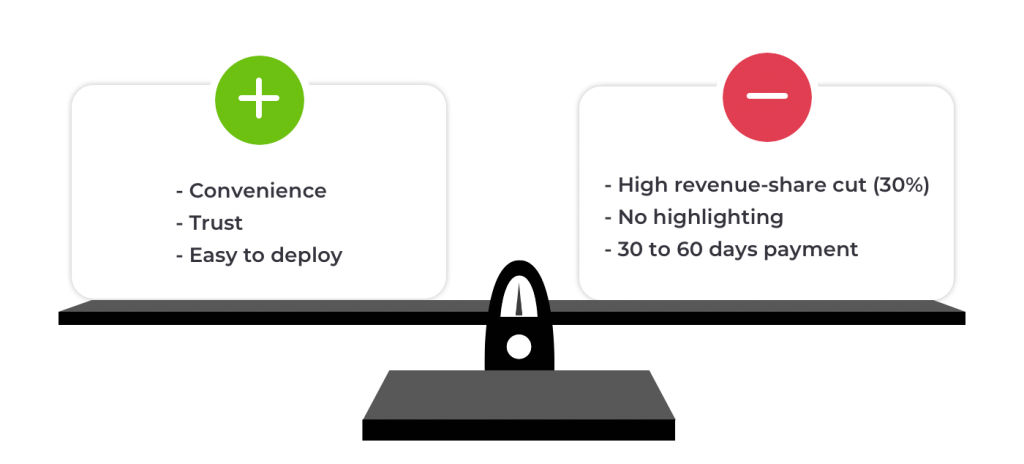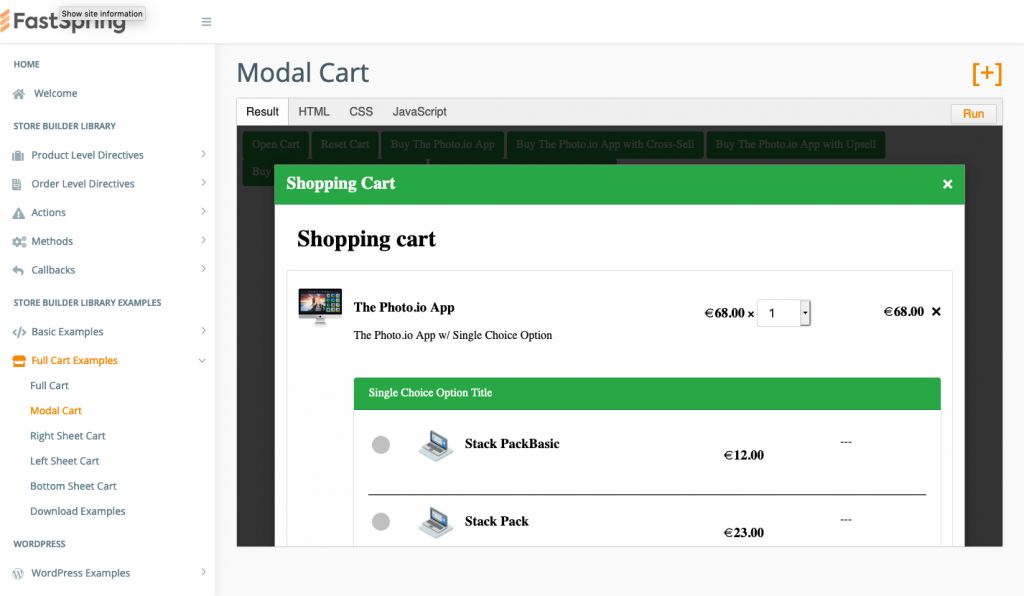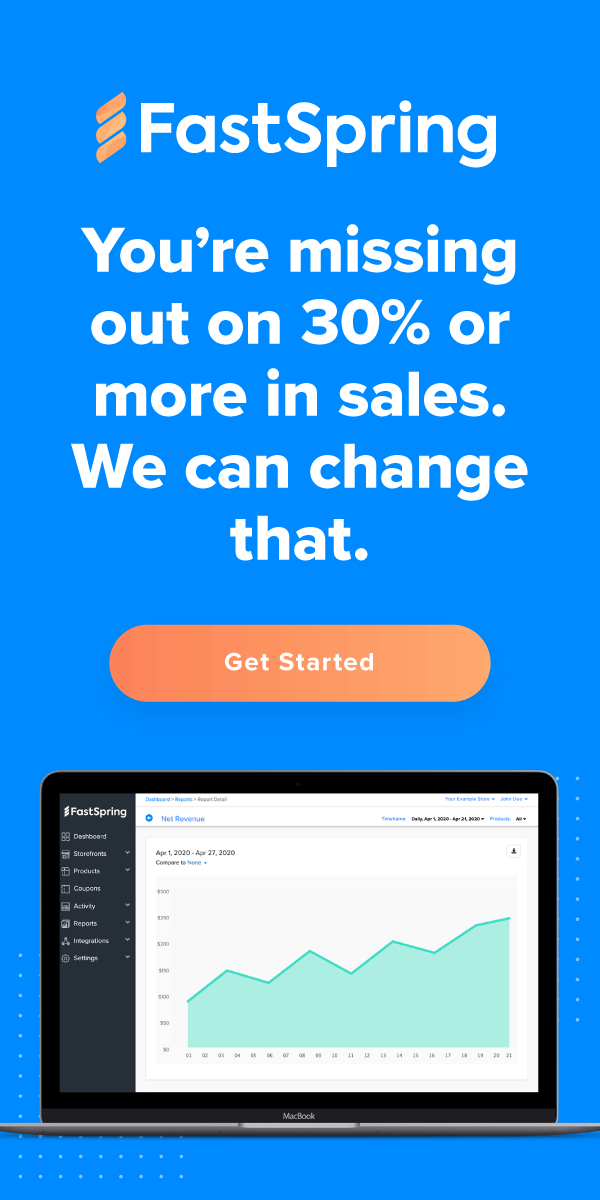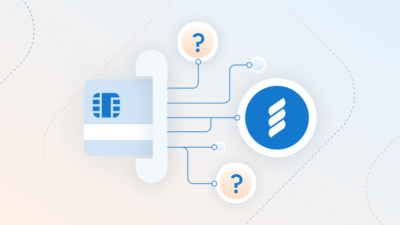Check out our more current post on how to sell a mobile app D2C, How to Sell a Mobile App or Game Outside App Stores.
The shine of distributing an app quickly wears off when developers realize that stores like Google Play and Apple Store take a chunk of the profits.
And it’s not a small chunk—it’s 30%. The hefty price tag has developers to look for alternative solutions. The good news for developers like you is, there are ways to distribute your app without having to share the revenue with mainstream channels.
In this piece, we are going to cover one way that developers can circumnavigate the hefty 30% fee from the Google Play and Apple Store.
Let’s dive in.
The Pros and Cons of Using Mainstream App Distribution Channels
Before we get into alternative ways of distributing apps, let’s take a look at how the mainstream app channels work.
As we’ve already pointed out, these Google Play and Apple Store take nearly a third of the revenue of every app sold through their stores. But that isn’t the only problem with distributing through these channels.
Most apps on the market are using these distributors to sell their products. So, there are millions of apps being sold via just two stores. This creates another problem: how do distributors make their apps stand out?
Aha! By advertising, of course.
On top of the 30% fee, distributors are also paying for advertising to get their apps seen. One case study found the real cost of app advertising. The company took a $10k budget and spread it across four different ad networks:
- Google AdWords
- Facebook Ads
- Twitter Ads
- iAds
The results found the cost per app installed varied from $1.43 up to $5.36.

If we add this cost to the mainstream distribution fee, it’s easy to see why developers are looking for alternative options. Some of the most downloaded apps, like Spotify and Netflix, are distributed through Play and App Store. But rather than having the distributor handle the billing, the companies have created their own system for their subscriptions.
And companies like Epic Games have taken matters into their own hands and made uber-popular game Fortnite only available for download on their website and in the Samsung Store. By doing so, they’ve managed to avoid the hefty 30% fee from the mainstream distributors.

Pro-tip: A full-service ecommerce platform like FastSpring takes the work out of subscription management. From acquisition to activation through to renewal, FastSpring helps your company successfully manage the entire app subscription lifecycle.
Other advantages of selling outside of the Google Play and Apple Store are:
- Alternative distributors rarely charge an app listing fee. Third-party app stores can promote your product better as you have a better chance of getting featured as an app of the day or on other promotional offerings
- Alternatives are more profitable than Google and Apple stores if app owners are offering localized apps that target specific countries
However, there are upsides to distributing apps through Google Play and Apple Store. Not only are the stores trusted by customers as a safe place to download, but it’s also easy to deploy apps through the channels.

Spotlight: How One Developer Makes Money Selling Outside the Major App Stores
When Christian Tietze started selling his products online, he wanted two things: more money and more control.
Tietze wrote about his experience in a post on his site. He found several issues with selling on the Mac App Store, including:
- 30% revenue cost (excluding VAT)
- You can’t provide a demo
- You can’t provide upgrade pricing
- You don’t get to know your customers
So, he started looking for ways to sell outside of the Mac App Store.
“Distributing via the App Store is convenient; everyone can see your product and download and update from one central place,” Tietze says.
“On the flip side, you lose more money with each transaction, you’re bound to the strict App Store Sandboxing policies, you cannot create special offers – and if Apple disables your account, your business is effectively closed.
“This doesn’t happen often, but it can happen.”
Tietze says he (and many other indie developers) have chosen to distribute their apps on their own platforms. He uses FastSpring to distribute his app, and the platform gives him the tools to offer bundled sales, discounts, and a custom store API.
“FastSpring offers a test storefront on the web and from within the app if you do in-app purchases. That’s very convenient to see if your checkout works and if your app transitions from “locked” to “paid,” he says.
Wrapping Up
When it comes to app distribution options for developers, it’s clear that times are changing.
In the past, the two main players in the app game, Google Play and Apple Store held all the cards. If developers wanted to give their apps a chance at succeeding, they had no choice but to distribute their apps across these platforms and pay the 30% fee.
However, developers are taking back control of their apps—and revenue streams.
Whether or not you choose a full-service partner like FastSpring to sell your apps directly from your website, or distribute them using alternative app stores, there are other options out there for you to distribute your products. Whether you want to reach customers in hard-to-reach demographics, distribute your app internally, or offer it as a one-click download, the options are endless.
Just remember that Google Play and Apple Store are popular for a reason—millions of consumers around the world trust them. But with the number of apps being downloaded through alternative distribution methods every day, it’s clear customers are open-minded when it comes to finding their ideal apps.

You can check how easy it is to make your site into a store using FastSpring Examples. Using the examples, you can set up different dummy stores to get a feeling for the tool’s capabilities of the Store Builder API. The examples also either include or link to documentation pages and CodePen-like source code demos.
Ready to start growing revenue by selling outside of the App store? Try FastSpring for free.
![[Customer Story] Why TestDome Considers FastSpring a Real Partner](https://fastspring.com/wp-content/themes/fastspring-bamboo/images/promotional/2023/FastSpring-TestDome-blog-thumbnail.jpg)








